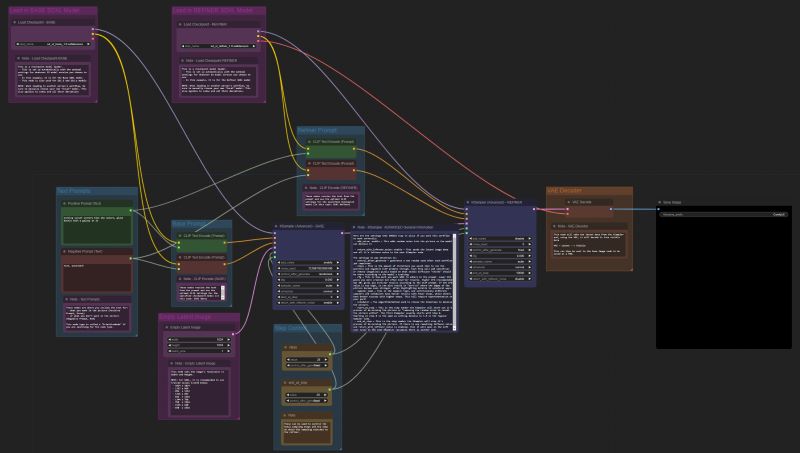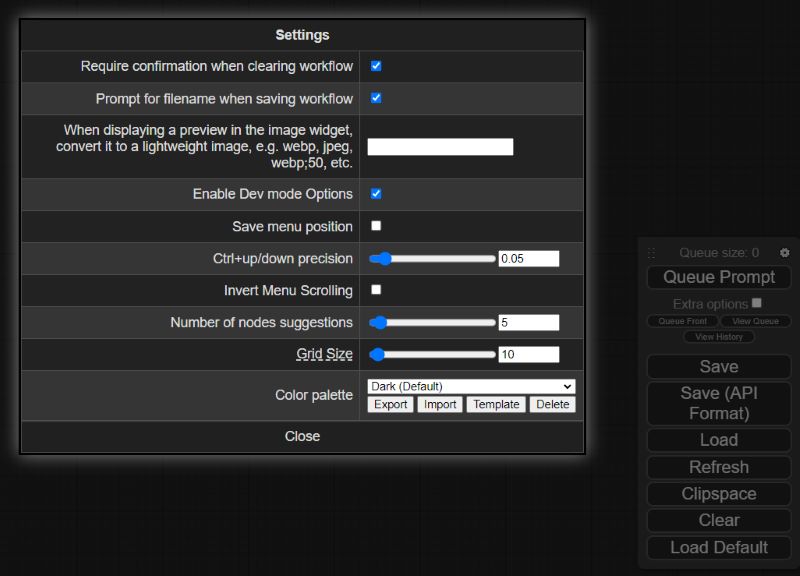The ComfyUI-to-Python-Extension is a powerful tool that translates ComfyUI workflows into executable Python code. Designed to bridge the gap between ComfyUI's visual interface and Python's programming environment, this script facilitates the seamless transition from design to code execution. Whether you're a data scientist, a software developer, or an AI enthusiast, this tool streamlines the process of implementing ComfyUI workflows in Python. The output makes it easy to queue a large amount of images for generation and provides a base script to easily modify for experimination.
Convert this:
To this:
import os
import random
import sys
from typing import Sequence, Mapping, Any, Union
import torch
def add_comfyui_directory_to_sys_path() -> None:
"""
Recursively looks at parent folders starting from the current working directory until it finds 'ComfyUI'.
Once found, the directory is added to sys.path.
"""
start_path = os.getcwd() # Get the current working directory
def search_directory(path: str) -> None:
# Check if the current directory contains 'ComfyUI'
if "ComfyUI" in os.listdir(path):
directory_path = os.path.join(path, "ComfyUI")
sys.path.append(directory_path)
print(f"ComfyUI found and added to sys.path: {directory_path}")
# Get the parent directory
parent_directory = os.path.dirname(path)
# If the parent directory is the same as the current directory, we've reached the root and stop the search
if parent_directory == path:
return
# Recursively call the function with the parent directory
search_directory(parent_directory)
# Start the search from the current working directory
search_directory(start_path)
def get_value_at_index(obj: Union[Sequence, Mapping], index: int) -> Any:
"""Returns the value at the given index of a sequence or mapping.
If the object is a sequence (like list or string), returns the value at the given index.
If the object is a mapping (like a dictionary), returns the value at the index-th key.
Some return a dictionary, in these cases, we look for the "results" key
Args:
obj (Union[Sequence, Mapping]): The object to retrieve the value from.
index (int): The index of the value to retrieve.
Returns:
Any: The value at the given index.
Raises:
IndexError: If the index is out of bounds for the object and the object is not a mapping.
"""
try:
return obj[index]
except KeyError:
return obj["result"][index]
add_comfyui_directory_to_sys_path()
from nodes import (
CLIPTextEncode,
KSamplerAdvanced,
CheckpointLoaderSimple,
VAEDecode,
SaveImage,
EmptyLatentImage,
NODE_CLASS_MAPPINGS,
)
def main():
with torch.inference_mode():
checkpointloadersimple = CheckpointLoaderSimple()
checkpointloadersimple_4 = checkpointloadersimple.load_checkpoint(
ckpt_name="sd_xl_base_1.0.safetensors"
)
emptylatentimage = EmptyLatentImage()
emptylatentimage_5 = emptylatentimage.generate(
width=1024, height=1024, batch_size=1
)
cliptextencode = CLIPTextEncode()
cliptextencode_6 = cliptextencode.encode(
text="Kylo Ren trapped inside of a Mark Rothko painting",
clip=get_value_at_index(checkpointloadersimple_4, 1),
)
cliptextencode_7 = cliptextencode.encode(
text="text, watermark", clip=get_value_at_index(checkpointloadersimple_4, 1)
)
checkpointloadersimple_12 = checkpointloadersimple.load_checkpoint(
ckpt_name="sd_xl_refiner_1.0.safetensors"
)
cliptextencode_15 = cliptextencode.encode(
text="Kylo Ren trapped inside of a Mark Rothko painting",
clip=get_value_at_index(checkpointloadersimple_12, 1),
)
cliptextencode_16 = cliptextencode.encode(
text="text, watermark",
clip=get_value_at_index(checkpointloadersimple_12, 1),
)
ksampleradvanced = KSamplerAdvanced()
vaedecode = VAEDecode()
saveimage = SaveImage()
for q in range(10):
ksampleradvanced_10 = ksampleradvanced.sample(
add_noise="enable",
noise_seed=random.randint(1, 2**64),
steps=25,
cfg=8,
sampler_name="euler",
scheduler="normal",
start_at_step=0,
end_at_step=20,
return_with_leftover_noise="enable",
model=get_value_at_index(checkpointloadersimple_4, 0),
positive=get_value_at_index(cliptextencode_6, 0),
negative=get_value_at_index(cliptextencode_7, 0),
latent_image=get_value_at_index(emptylatentimage_5, 0),
)
ksampleradvanced_11 = ksampleradvanced.sample(
add_noise="disable",
noise_seed=random.randint(1, 2**64),
steps=25,
cfg=8,
sampler_name="euler",
scheduler="normal",
start_at_step=20,
end_at_step=10000,
return_with_leftover_noise="disable",
model=get_value_at_index(checkpointloadersimple_12, 0),
positive=get_value_at_index(cliptextencode_15, 0),
negative=get_value_at_index(cliptextencode_16, 0),
latent_image=get_value_at_index(ksampleradvanced_10, 0),
)
vaedecode_17 = vaedecode.decode(
samples=get_value_at_index(ksampleradvanced_11, 0),
vae=get_value_at_index(checkpointloadersimple_12, 2),
)
saveimage_19 = saveimage.save_images(
filename_prefix="ComfyUI", images=get_value_at_index(vaedecode_17, 0)
)
if __name__ == "__main__":
main()
-
Navigate to your
ComfyUIdirectory -
Clone this repo
git clone https://github.com/pydn/ComfyUI-to-Python-Extension.git
After cloning the repo, your
ComfyUIdirectory should look like this:/comfy /comfy_extras /ComfyUI-to-Python-Extension /custom_nodes /input /models /output /script_examples /web .gitignore LICENSE README.md comfyui_screenshot.png cuda_mollac.py execution.py extra_model_paths.yaml.example folder_paths.py latent_preview.py main.py nodes.py requirements.txt server.py -
Navigate to the
ComfyUI-to-Python-Extensionfolder and install requirementspip install -r requirements.txt
-
Launch ComfyUI, click the gear icon over
Queue Prompt, then checkEnable Dev mode Options. THE SCRIPT WILL NOT WORK IF YOU DO NOT ENABLE THIS OPTION!
-
Load up your favorite workflows, then click the newly enabled
Save (API Format)button under Queue Prompt -
Move the downloaded .json workflow file to your
ComfyUI/ComfyUI-to-Python-Extensionfolder -
If needed, update the
inputvariable at the bottom ofcomfyui_to_python.pyto match the name of your .json workflow file. By default, the script will look for a file calledworkflow_api.json. You can also update thequeue_sizevariable to your desired number of images that you want to generate in a single script execution. By default, the scripts will generate 10 images. -
Run the script:
python comfyui_to_python.py
-
After running
comfyui_to_python.py, a new .py file will be created in the current working directory that contains the same name as theinputvariable. If you made no changes, look forworkflow_api.py. -
Now you can execute the newly created .py file to generate images without launching a server.

